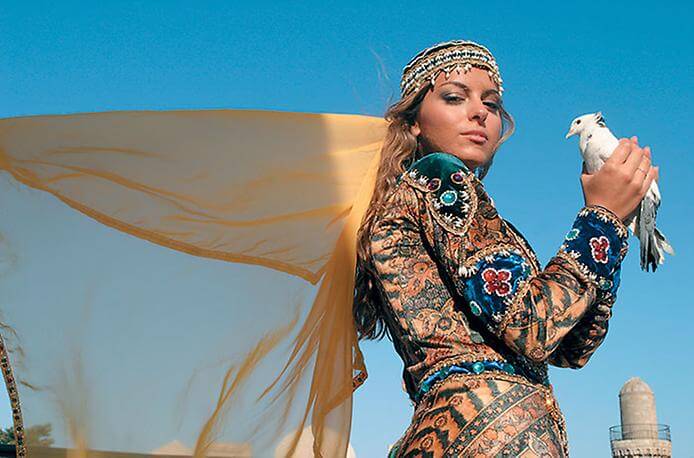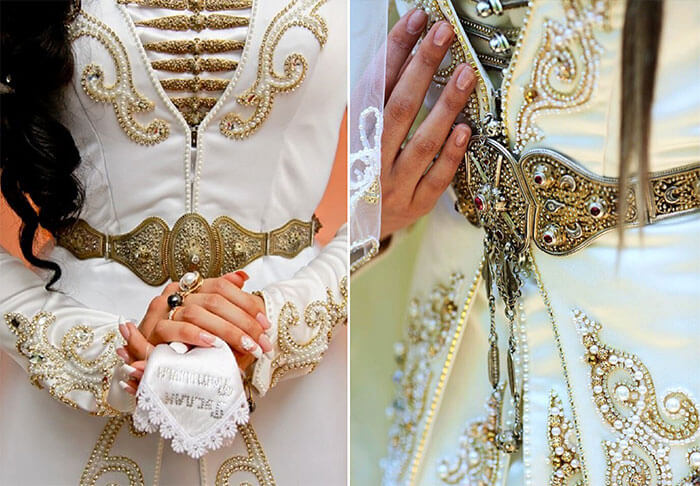Embroidered clothes of the Caucasian region
.png)
Since ancient times people are used to sense beauty, which they tried to put into linen. That’s why ornamental masterpieces talk to us, as if alive, slowly telling the story of their nation. We can find a great variety of bright, unique colours, exquisite embroidered patterns while traveling the Caucasian region.
The Georgian embroidery
The Georgian national traditions involve the use of embroidery in many spheres of human activity. Here one can observe embroidered handbags, prayer books decorated with small crosses and other religious books, as well as handmade dolls dressed in richly embroidered costumes.
Georgians are used to practically embroider their everyday clothes. Craftswomen embroider overhead collars, textile bracelets and necklaces with beads or gold threads that is much easier than entirely dress or blouse embroidery. In addition, these decorations are easily used, as they can be combined with other clothes according to some occasion and one’s mood.
Despite the fact that Georgia is a mountainous country, the vegetative pattern is traditionally used. Georgians gladly wear festive and everyday clothing adorned with embroidered poppies, daisies, cornflowers and other wildflowers. At first, European tourists are surprised at a range of colours of embroidered things. They are made in strict colours: wine red, brown, green and sand colours prevail. Although, of course, gold and silver threads skillfully embroidered on canvas make them really festive.
It is worth mentioning that the traditional national costume of Georgians worn only on high holy days is generously adorned with bright embroidery. This makes their clothing unique and inimitable.
Embroidered clothes of Armenians
The Armenian embroidery belongs to one of the oldest kinds of needlework. The Armenian craftswomen like decorating not only clothes, but also various usual household things.
There are several names for the original Armenian embroidery: “weave”, “marash”, and “Maltese embroidery”. The latter is widely used. This technique originated and became popular in Armenia, being known as the Armenian embroidery. It has been known as “Maltese” since the Middle Ages, after the establishment of trade ties with Malta. The Armenian villagers used this embroidery technique to decorate bedspreads, tablecloths, towels and other household things.
It is worth mentioning that the patterns used by the Armenians resemble a complex weave of stone patterns of folk artisans. Today we notice that their clothing features various embroidered geometric shapes, crosses and stars, a mysterious ornamental ligatured script of the Armenian alphabet.
Armenians embroider on silk, cotton, and canvas. They also use thin wool fabrics. The combination of textures and a unique ornament create a wonderful harmony reminiscent of music sounding through centuries.

The Dagestanian embroidery
The national costumes of the North Caucasus, namely Dagestan is a real miracle of gold and silver embroidery. It is worth mentioning that unlike other regions, Dagestanians are used to decorate festive clothing only. Their embroidery features the use of gold and silver threads, expensive velvet and silk. It seems that festive dresses are covered with magical patterns. It is difficult to imagine the importance of a careful selection of an appropriate ornament, as well as its skillful putting into linen.
In everyday life, most people use a simple embroidery with coloured threads. Such things have a sacral meaning. The Dagestanian craftswomen embroider baby bedspreads, funerary palls, small purses for girls, and horse saddle clothes. The patterns for such things are traditional and serve as a talisman.
It is remarkable that both men and women are engaged in embroidery in the Caucasus. There is no doubt that embroidery is a multiethnic notion, while the art of decorating clothes with threads is immortal.

Since ancient times people are used to sense beauty, which they tried to put into linen. That’s why ornamental masterpieces talk to us, as if alive, slowly telling the story of their nation. We can find a great variety of bright, unique colours, exquisite embroidered patterns while traveling the Caucasian region.
The Georgian embroidery
The Georgian national traditions involve the use of embroidery in many spheres of human activity. Here one can observe embroidered handbags, prayer books decorated with small crosses and other religious books, as well as handmade dolls dressed in richly embroidered costumes.
Georgians are used to practically embroider their everyday clothes. Craftswomen embroider overhead collars, textile bracelets and necklaces with beads or gold threads that is much easier than entirely dress or blouse embroidery. In addition, these decorations are easily used, as they can be combined with other clothes according to some occasion and one’s mood.
Despite the fact that Georgia is a mountainous country, the vegetative pattern is traditionally used. Georgians gladly wear festive and everyday clothing adorned with embroidered poppies, daisies, cornflowers and other wildflowers. At first, European tourists are surprised at a range of colours of embroidered things. They are made in strict colours: wine red, brown, green and sand colours prevail. Although, of course, gold and silver threads skillfully embroidered on canvas make them really festive.
It is worth mentioning that the traditional national costume of Georgians worn only on high holy days is generously adorned with bright embroidery. This makes their clothing unique and inimitable.
Embroidered clothes of Armenians
The Armenian embroidery belongs to one of the oldest kinds of needlework. The Armenian craftswomen like decorating not only clothes, but also various usual household things.
There are several names for the original Armenian embroidery: “weave”, “marash”, and “Maltese embroidery”. The latter is widely used. This technique originated and became popular in Armenia, being known as the Armenian embroidery. It has been known as “Maltese” since the Middle Ages, after the establishment of trade ties with Malta. The Armenian villagers used this embroidery technique to decorate bedspreads, tablecloths, towels and other household things.
It is worth mentioning that the patterns used by the Armenians resemble a complex weave of stone patterns of folk artisans. Today we notice that their clothing features various embroidered geometric shapes, crosses and stars, a mysterious ornamental ligatured script of the Armenian alphabet.
Armenians embroider on silk, cotton, and canvas. They also use thin wool fabrics. The combination of textures and a unique ornament create a wonderful harmony reminiscent of music sounding through centuries.

The Dagestanian embroidery
The national costumes of the North Caucasus, namely Dagestan is a real miracle of gold and silver embroidery. It is worth mentioning that unlike other regions, Dagestanians are used to decorate festive clothing only. Their embroidery features the use of gold and silver threads, expensive velvet and silk. It seems that festive dresses are covered with magical patterns. It is difficult to imagine the importance of a careful selection of an appropriate ornament, as well as its skillful putting into linen.
In everyday life, most people use a simple embroidery with coloured threads. Such things have a sacral meaning. The Dagestanian craftswomen embroider baby bedspreads, funerary palls, small purses for girls, and horse saddle clothes. The patterns for such things are traditional and serve as a talisman.
It is remarkable that both men and women are engaged in embroidery in the Caucasus. There is no doubt that embroidery is a multiethnic notion, while the art of decorating clothes with threads is immortal.


Comments
No comment at this time!
Leave your comment